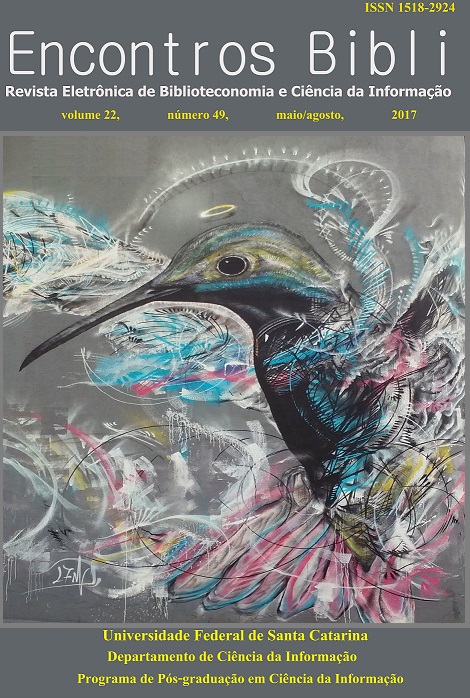Taxonomy of accounting distorsions
DOI:
https://doi.org/10.5007/1518-2924.2017v22n49p127Keywords:
Information Management, Organization and Representation of Information, Documentary Language, Taxonomy, Accounting Audit, Knowledge ManagementAbstract
http://dx.doi.org/10.5007/1518-2924.2017v22n49p127
Discusses the use of a taxonomy of accounting distortions arising from errors and fraud, focused, for the use of auditors, on risk analysis and selection of audit procedures. Its development follows the conceptual guidelines of faceted classification, through conceptual survey in literature. The referred taxonomy has as fundamental categories the phases of information, such as essential aspects, statements, resource cycles, resource sub-cycles, accounting distortions and statements (audit objectives). It is presented to the taxonomy development methodology and its applicability in the accounting audit as an organizing tool of information and knowledge. From the examples used, it concludes that it can be said that taxonomy guides the analysis of distortions as an audit trail, standardizing the concepts identified in natural language in a standardized classification structure.
Downloads
References
ALBUQUERQUE, S. F. de; ARAÚJO JÚNIOR, R. H. de Morfologia para representação das necessidades de informação gerencial. Em Questão, Porto Alegre, v. 20, n.2, p. 166-187, jul./dez. 2014.
BAPTISTA, D. M.; ARAÚJO JÚNIOR, R. H. de; CARLAN, E. O escopo da análise da informação. In: ROBREDO, J.; BRÄSCHER M. (Orgs.). Passeios pelo bosque da informação: estudos sobre representação e organização da informação e do conhecimento EROIC. Brasília: IBICT, 2010, p. 115-119. Disponível em:
<http://www2.senado.leg.br/bdsf/item/id/189812>. Acesso em: 01 nov. 2016.
BRÄSCHER, M.; CARLAN, E. Sistemas de organização do conhecimento: antigas e novas linguagens. In: ROBREDO, J.; BRÄSCHER M. (Orgs.). Passeios pelo bosque da informação: estudos sobre representação e organização da informação e do conhecimento EROIC. Brasília: IBICT, 2010, p. 147-176. Disponível em:
<http://www2.senado.leg.br/bdsf/item/id/189812>. Acesso em: 03 nov. 2016.
BOYNTON, W. C.; JOHNSON, R. N.; KELL, W. G. Auditoria. 7 ed. São Paulo: Atlas, 2002.
CAMPOS, M. L. A.; GOMES, H. E. Taxonomia e classificação: o princípio de categorização. DataGramaZero, Rio de Janeiro, v. 9, n. 4, ago. 2008.
DAHLBERG, I. Teoria do conceito. Ciência da Informação, Brasília, v.7, n.2, p. 101-107, 1978. Disponível em: <http://revista.ibict.br/ciinf/article/view/115>. Acesso em: 15
out. 2016.
GIESS, M.; McMAHON, C.; BOOKER, J. D.; STEWART, D. Application of faceted classification in the support of manufacturing process selection. Proceedings of the Institution of Mechanical Engineers, part B: Journal of Engineering Manufacture, v. 223, n. 6, p. 597-608, 2009.
GUEDES, W.; ARAÚJO JÚNIOR, R. H. de. Estudo das similaridades entre a teoria matemática da comunicação e o ciclo documentário. Informação & Sociedade: Estudos, João Pessoa, v. 24, n. 2, p. 71-81, maio/ago. 2014. Disponível em:<http://www.ies.ufpb.br/ojs/index.php/ies/article/viewFile/16498/11492>. Acesso em: 02 nov. 2016.
HSIAO, Y. L. An audit-based prediction model for aviation maintenance safety. Buffalo: Faculty of the Graduate School of the State University of New York at Buffalo, 2011. (Tese de Doutorado).
MILNE, C. (2007). Taxonomy development: assessing the merits of contextual classification. Records Management Journal, v. 17, n. 1, 7-16, 2007. Disponível em:<https://repository.abertay.ac.uk/jspui/handle/10373/80>. Acesso em: 03 nov. 2016.
SOUSA, R. T. B. de.; ARAÚJO JÚNIOR, R. H. de. A classificação e a taxonomia com instrumentos efetivos para a recuperação da informação arquivística. Ciência da Informação, Brasília, DF, v. 41, n. 1, p.148-160, jan./abr. 2013. Disponível em: <http://revista.ibict.br/ciinf/article/view/1400/1578>. Acesso em: 02 nov. 2016.
VITAL, L. P.; CAFÉ, L. M. A. Práticas de elaboração de taxonomias: análise e recomendações. VIII Encontro Nacional de Pesquisa em Ciência da Informação. Salvador: VIII ENANCIB, 2007. Disponível em:
<http://www.enancib.ppgci.ufba.br/artigos/GT2--141.pdf>. Acesso em 14 out. 2016.
VOGEL, M. J. M. Taxonomia: produto ou processo? Biblioteca Terra Fórum Consultores, 2011. Disponível em:
<http://www.terraforum.com.br/biblioteca/Documents/libdoc00000192v001taxonomia_%20produto_ou_processo.pdf>. Acesso em: 11 out. 2016.
WALDEN, C. T. A taxonomy based assessment methodology for small and medium size manufacturers. Starkville: Faculty of Mississippi State University, Mississippi State University, 2007. (Tese de Doutorado).
YOSHITAKE, M. Auditoria contábil: metodologia de processo de auditoria. Curitiba: Juruá, 2009.
Published
How to Cite
Issue
Section
License
Copyright (c) 2017 José Humberto da Cruz Cunha, Rogério Henrique de Araújo Júnior

This work is licensed under a Creative Commons Attribution 4.0 International License.
The author must guarantee that:
- there is full consensus among all the coauthors in approving the final version of the document and its submission for publication.
- the work is original, and when the work and/or words from other people were used, they were properly acknowledged.
Plagiarism in all of its forms constitutes an unethical publication behavior and is unacceptable. Encontros Bibli has the right to use software or any other method of plagiarism detection.
All manuscripts submitted to Encontros Bibli go through plagiarism and self-plagiarism identification. Plagiarism identified during the evaluation process will result in the filing of the submission. In case plagiarism is identified in a manuscript published in the journal, the Editor-in-Chief will conduct a preliminary investigation and, if necessary, will make a retraction.
This journal, following the recommendations of the Open Source movement, provides full open access to its content. By doing this, the authors keep all of their rights allowing Encontros Bibli to publish and make its articles available to the whole community.
Encontros Bibli content is licensed under a Creative Commons Attribution 4.0 International License.
Any user has the right to:
- Share - copy, download, print or redistribute the material in any medium or format.
- Adapt - remix, transform and build upon the material for any purpose, even commercially.
According to the following terms:
- Attribution - You must give appropriate credit, provide a link to the license, and indicate if changes were made. You may do so in any reasonable manner, but not in any way that suggests the licensor endorses you or your use.
- No additional restrictions - You may not apply legal terms or technological measures that legally restrict others from doing anything that the license permits.

























